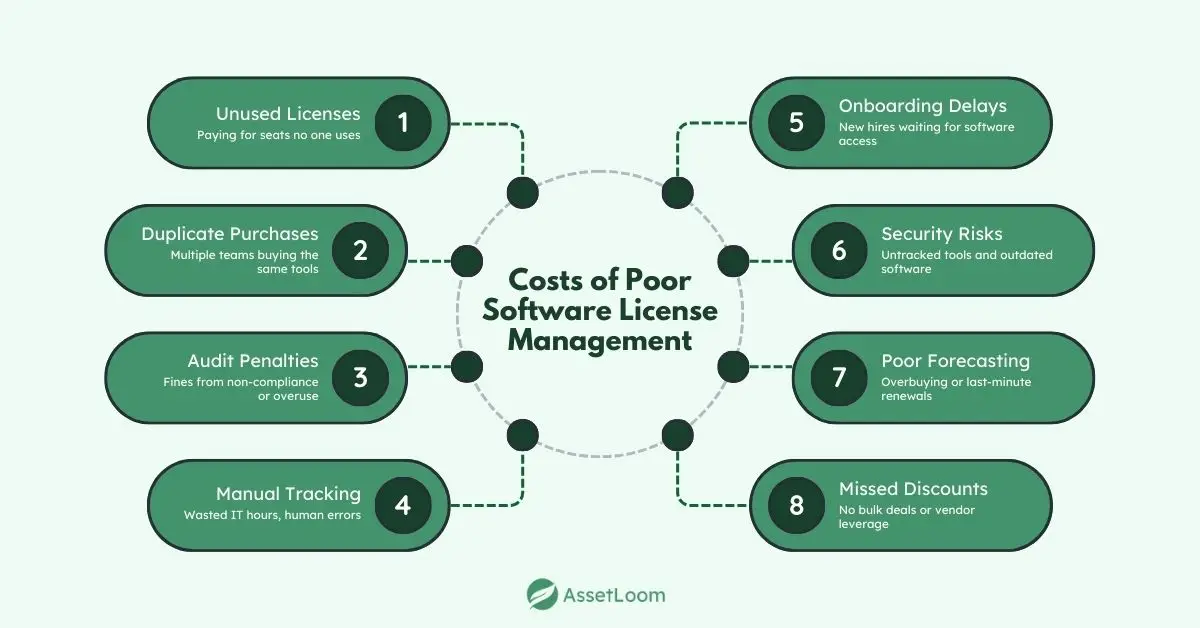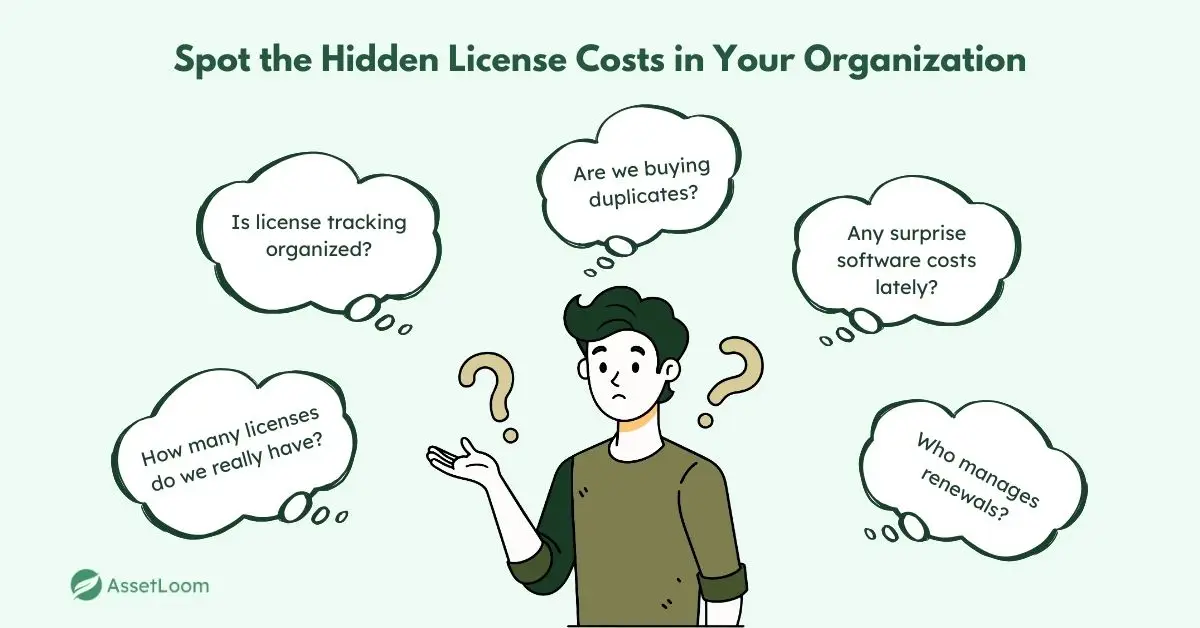8 Hidden Costs of Poor Enterprise Software License Management
Poor software license management can drain your budget. Discover 8 hidden costs—and how to avoid them.
Imagine paying thousands of dollars every year for software licenses your teams don’t even use. Or facing a surprise audit that hits you with hefty fines because your records aren’t up to date. These are just a few ways poor enterprise software license management can quietly drain your budget and put your business at risk.
Most companies don’t realize how many hidden costs are hidden behind sloppy license tracking. It’s not just about losing money—it’s about wasted time, project delays, security gaps, and unexpected compliance penalties.
In this post, we’re going to reveal 8 hidden costs that could be hurting your business right now. Understanding these will help you stop wasting resources and take control of your software spend before it’s too late.

1. Overpaying for Unused Licenses
One of the biggest hidden costs comes from paying for software licenses that your teams don’t actually use. It’s easy to buy licenses “just in case,” but those extra seats can add up fast.
Imagine buying 500 licenses but only using 300. That means you’re throwing money away on 200 unused seats every single year. Over time, this wastes thousands — maybe even tens of thousands — of dollars that could be better spent elsewhere.
The problem is, without clear visibility, it’s hard to know which licenses are truly needed. So companies keep renewing everything, just to be safe. This cautious approach ends up costing more than it saves.
Cutting down on unused licenses means you only pay for what your teams actually need. It’s a simple step that can free up budget and reduce waste immediately.
2. Duplicate License Purchases Across Teams
When departments buy software on their own, they often end up paying for the same thing twice. Without a central system in place, it’s easy for teams to use separate budgets to buy overlapping tools.
For example, marketing might pay for a design tool, while the product buys a nearly identical one. Both teams spend money, and neither realizes there’s an opportunity to share or consolidate.
These duplicate purchases waste money and make support, billing, and renewals more complicated than they need to be. Over time, that money quietly slips through the cracks.
Centralizing software purchases helps you catch duplicates early, reduce overlap, and get more value from your spend.
3. Audit Penalties and Legal Risks
When your license records are out of date or incomplete, you’re more likely to get hit with fines during a vendor audit. And those fines can be steep.
Let’s say you have more users than your license allows. If an audit uncovers this, you’ll likely have to pay for the extra usage and possibly face backdated fees or penalties.
It’s not just about money, either. Some audits disrupt operations or trigger legal reviews, especially if your company operates in a regulated industry.
Keeping clean, accurate records helps you avoid these surprises and stay in the clear during audits.
4. Manual Tracking Wastes IT Time
Many IT teams still manage software licenses using spreadsheets. It might work for a while, but it’s a time sink.
Every time someone updates a license, adds a new user, or renews a subscription, someone has to go in and make changes manually. That adds up quickly — not just in hours, but in missed opportunities.
Plus, with so many manual steps, it’s easy to make mistakes. A small error in tracking can snowball into a big billing or compliance problem later on.
Automating license tracking saves time, reduces errors, and lets your IT team focus on what matters.
5. Delays in Onboarding or Project Launches
When software licenses aren’t properly managed, people can’t always access the tools they need when they need them. That slows everything down.
Think about a new hire who’s ready to start work, but can’t log into key systems for days. Or a project team that’s stuck waiting for licenses before they can kick things off.
These delays cost time, frustrate employees, and can even affect your bottom line if project deadlines get pushed.
A smarter license management system makes sure the right tools are always ready for the right people.
6. Security and Compliance Risks
Old, untracked, or expired software can open the door to serious security issues. The more unknowns in your system, the harder it is to keep things safe.
Unlicensed or outdated software often doesn’t get critical updates. That leaves you exposed to vulnerabilities, and if you work in a regulated industry, it could mean breaking compliance rules too.
Without good visibility, it’s also harder to spot unauthorized tools that employees might install on their own.
Better license tracking helps you stay secure, compliant, and in control of your software environment.
7. Poor Forecasting and Budget Planning
It’s hard to plan ahead when you don’t know what you’re using right now. Without solid data on license usage, forecasting future needs becomes guesswork.
You might end up overbuying to be safe, or underbuying and scrambling when demand spikes. Either way, you’ll likely spend more than necessary and miss the chance to plan proactively.
Plus, last-minute license renewals often cost more than planned purchases, putting extra pressure on your budget.
With better tracking, you get the insights you need to plan smarter and spend more strategically.
8. Missed Volume Discounts or Negotiation Opportunities
Vendors usually offer discounts when you buy in bulk, but if teams are purchasing software separately, you miss out on those deals.
Say three departments each buy 20 licenses on their own. If they’d coordinated, they could’ve negotiated a better price for 60 licenses together. That missed opportunity quietly chips away at your software budget.
Decentralized purchasing also weakens your negotiating power when contracts come up for renewal.
When you centralize software buying, you gain leverage—and that means lower costs and better terms across the board.
How to Spot These Hidden Costs in Your Own Organization
Now that you know what these hidden costs look like, the next step is figuring out whether they’re quietly draining your budget.
Start by asking a few simple questions:
- Do you know how many licenses you’ve purchased—and how many are actually being used?
- Are different departments buying software separately?
- How is your team tracking license renewals, usage, and compliance?
- Have you faced any delays, audits, or unexpected software expenses in the past year?
If you’re not sure about the answers, it might be time to take a closer look at how your software assets are managed. Many teams find it helpful to use IT asset management (ITAM) tools to get better visibility into license usage, track renewals more easily, and reduce manual errors.
It doesn’t have to be a major change—just having a more centralized and transparent way to track software can help you uncover waste and stay ahead of potential issues.

Take Control Before the Costs Catch Up
Software licenses might not seem like a major concern day to day, but when mismanaged, they quietly chip away at your budget, your time, and your team’s productivity.
The hidden costs we covered aren’t rare exceptions. They’re common pitfalls that show up in almost every organization without clear oversight. The good news? They’re also preventable.
By taking a closer look at how your licenses are tracked, shared, and renewed, you can start uncovering waste and making smarter decisions. It’s not about perfection—it’s about visibility and control.
Start small. Review what you’re already using, look for overlap, and consider whether your current tools are helping or holding you back. The sooner you take action, the easier it becomes to protect your budget and your business from unexpected surprises.

Subscribe for Expert Tips and Updates
Receive the latest news from AssetLoom, right in your inbox.

